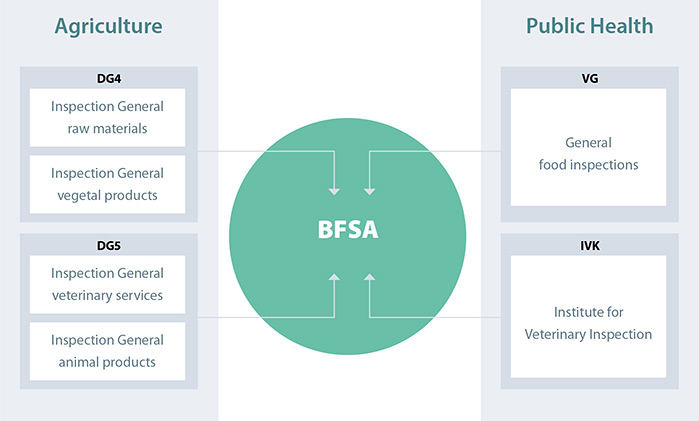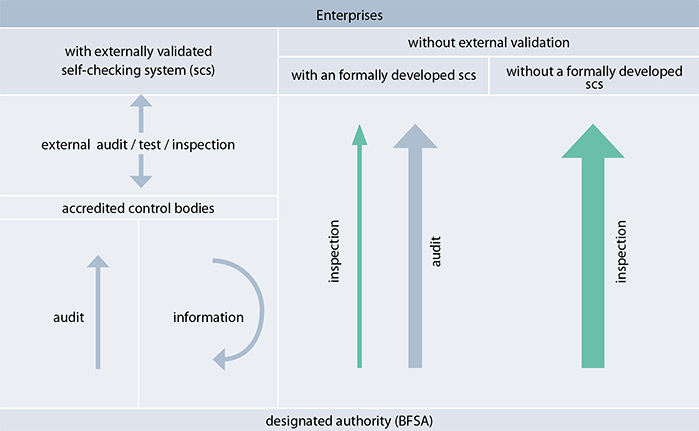 |
BFSA - BUSINESS PLAN 2015-2017 Belgian Food Safety Agency |
| FR | NL | DE | EN |
|
|
| The BFSA as an organization |
Social, economic and administrative context | Stakeholders vision | Strategic and operational objectives 2015-2017 |
Inspection frequencies | State of affairs of the objectives |
|
Introduction In the aftermath of the dioxin crisis of 1999, the government decided that all control and inspection services which are dealing with food safety had to be reorganized so as to improve their efficiency. This led to the creation of the Belgian Food Safety Agency by the law of 4 February 2000. The BFSA is a semigovernmental type A institution. The first business plan had been drawn up by the then CEO at the explicit request of the government so as to have a policy document for the BFSA. In his business plan of 15 September 2000, approved by the government on 22 November 2000, the major policy options, still actual today, were already outlined. It provided for the control of the entire chain by installing a global monitoring program, the necessity of self-checking systems of which its implementation can also be verified by neutral third parties. The basic elements of self-checking were described - the registration of FFBO’s, traceability, mandatory notification and the application of internationally accepted standards such as HACCP. The need for an adapted system for smaller enterprises had been recognized too. The funding of the BFSA had to be neutral on the budgetary level, with contributions by the sectors for funding the control activities in function of their risk. Enterprises having implemented and maintained a self-checking system had to obtain a financial stimulus. A collaboration with the different stakeholders had to be aimed at. The structure of the BFSA and the integration of the different services were roughly laid down, including a crisis cell, a communication cell and a consumer helpline. The initial focus was on the development of new structures, the integration of several services (from the Ministries of Agriculture, Public Health and the Institute for veterinary Inspection) and the development of a new control policy. Origin of the BFSA  From 2002 the development of the BFSA accelerated, based on the work which had been carried out and after a new board of directors had been designated. In 2003, the Agency had a proper budget and in that same year the Royal Decree concerning selfchecking came into force. In 2004, the integration of the different services had finally been completed and for the first time, the Agency worked on the basis of a global programme for all sectors, products and risks based on a risk assessment. After finalizing the internal integration and the foundations had been laid for a new policy, it was necessary to draw up a new business plan which focused on the development of a reliable organisation and operational efficiency. The second business plan, drawn up for the period 2005-2008, started from the core process of the BFSA, its relation with the stakeholders, the new structure and a SWOT-analysis implemented internally as well as externally. A strategic vision was developed, the aim of which was to create an added value in 5 broad result areas - realizing a safe food chain, a reliable image, maintaining a stable legal framework, pursuing the complementarity with the sectors and an excellent operational service. The vision was developed in 11 strategic targets. The implementation of the validation of the self-checking systems by third parties and by the BFSA, the external certification of the quality systems of the BFSA, an efficient risk assessment, an integrated IT system, communication to consumers and FFBO’s and of course a new financing system were some of the innovative goals set out for the Agency. The stimulation of self-checking  The business plans 2009-2011 and 2012-2014 were not only based on the realizations of the preceding business plans, but each also emphasized different aspects, such as a context analysis, administratively as well as socio-economically, the fine-tuning of the financing, inspection frequencies were determined and the inspection was formalized. Attention was paid to the FFBO’s’ and consumers’ acceptance, to transparency, to the stimulation of self-checking, to cutting the red tape and to the export of products from the agro-food industry, the development of quality assurance and of efficient IT-tools, more training for FFBO’s,...
Meanwhile, the list of the realisations is impressive :
These realisations can serve as a basis for developing the new business plan. The approach will be directed both by aiming at a continuous improvement and by being responsive to new societal trends. But despite this solid basis, the BFSA faces a new and important challenge - maintaining the maximum of its activities in times of major cutbacks. In general these cutbacks imply :
For the BFSA, these cutbacks are only applied on the part of the expenditure covered by public funding (60%). This implies that the budget of € 176,059,936 in 2014 has been reduced to a budget of € 162,436,732 in 2015 or a reduction of € 13,623,204. Cutbacks will have an impact on the organization itself as well as on the partners with whom it collaborates. Compared with 2008, when expenditure budget still amounted to € 186 million it is clear that in recent years significant efforts have been made to preserve the BFSAactivities, but these additional efforts will certainly have an effect on services rendered to consumers and enterprises. |
|